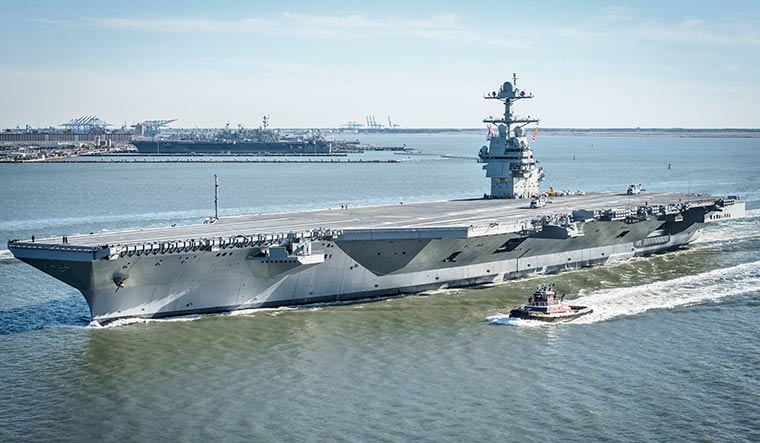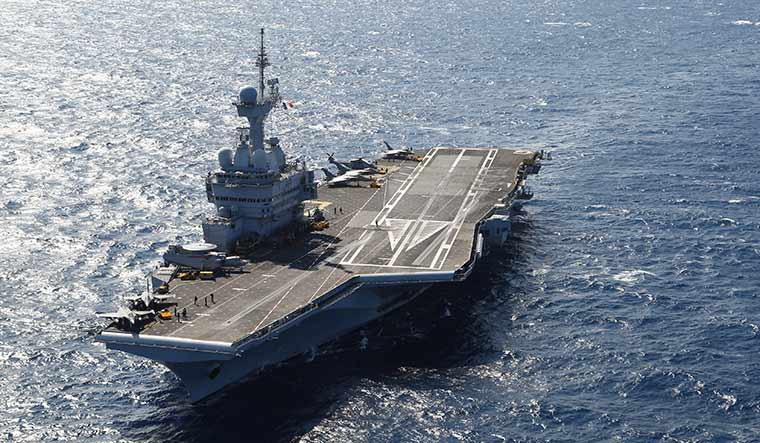THE RUSSO-JAPANESE war of 1905 shook the world for two reasons. One, for the first time an Asian power defeated a European power in a naval war. Two, the winners, the Japanese, converted a vessel they had captured from the Russian fleet, fashioned it into a seaplane carrier, and began projecting power. It would conduct the first naval-launched air raids during World War I.
Wakamiya was modified as a regular aircraft carrier in 1920. It was scrapped in 1932, nine years before six Japanese aircraft carriers attacked the US naval base at Pearl Harbour in Hawaii. The attack on Pearl Harbour, on December 7, 1941, validated the power of aircraft carriers.
World War II Japan had 26 aircraft carrier fleet, which included Hosho, the first purpose-built aircraft carrier in the world. After the atomic bombings of Hiroshima and Nagasaki, Japan entered a period of disarmament and dejection. Today, it has two major helicopter carriers—Izumo and Kaga—but no aircraft carrier. There are, however, plans to convert a helicopter carrier into an aircraft carrier.
The earliest documented occurrence of using a ship for airborne operations was in 1806, when Lord Cochrane of the British Royal Navy launched kites from HMS Pallas (32-gun frigate), to unload propaganda leaflets against Napoleon Bonaparte. The leaflets were tied to kites and they landed on French soil when the strings completely burned.
Many years later, in 1849, inflammable balloons were launched from the Austrian ship SMS Vulcano, for dropping bombs on Venice. The attempt failed, as winds drove the balloons back over the ship.
There were 241 aircraft carriers in the world during World War II. The US had 105 of them. In 1960, it launched the first nuclear-powered aircraft carrier, Enterprise. Over the years, the US has made use of aircraft carriers in the Persian Gulf and Afghanistan, and also to safeguard its interests in the Pacific. After invading Iraq in 2003, aircraft carriers became the principal base of American airpower.
In the early 1940s the US designed a series of 45,000-tonne ships. The Midway, a class of three aircraft carriers, was built with armoured flight decks. Today, the US has 11 aircraft carriers, 10 of them Nimitz class—these are the largest warships in the world. The Nimitz carrier is nuclear-powered and needs refuelling only once in its 50-year service life. It displaces one lakh tonnes.
Nimitz will soon make way for five Gerald R. Ford carriers. Though its hull is similar to Nimitz, Ford will have more space, speed and power, and greater displacement.
The British navy has two Queen Elizabeth-class aircraft carriers. Interestingly, during its initial deployment earlier this year, HMS Queen Elizabeth spotted Chinese submarines on the South China Sea, after which accompanying frigates and helicopters cornered the Chinese.
Also read
- INS Vikrant docks at Karwar base, Navy calls it 'landmark'
- INS Vikrant proof of India's skill and talent: PM Modi
- PM Modi to commission home-made aircraft carrier Vikrant today
- How an aircraft carrier projects power deep into the coast
- The making of INS Vikrant
- Need three aircraft carriers: Vice Admiral M.A. Hampiholi
China’s third aircraft carrier, Fujan, has a weight of 80,000 tonnes and can carry up to 50 aircraft, including manned drones and boats. Though yet to be commissioned, it is more powerful and more technically advanced than the other two carriers, Liaoning and Shandong. These two entered service in 2012 and 2019, respectively. China, though, has been operating aircraft carriers since the 1980s.
The French have a nuclear-powered carrier, named after Charles de Gaulle. Launched in 1994, it made its first voyage in 2001. It can carry 40 aircraft and has a displacement of 38,000 tonnes.
Vikrant is India’s fourth aircraft carrier. While Vikrant (1961-1997) and Viraat (1987-2016) were of British origin, Vikramaditya (2013 onwards) is of Russian origin. Russia stopped making aircraft carriers after the collapse of the Soviet Union, whose biggest shipyard was in Ukraine. Russia’s only aircraft carrier now is Admiral Kuznetsov, which has a displacement of 60,000 tonnes and can carry 40 helicopters and aircraft.
With inputs from Ajish P. Joy




